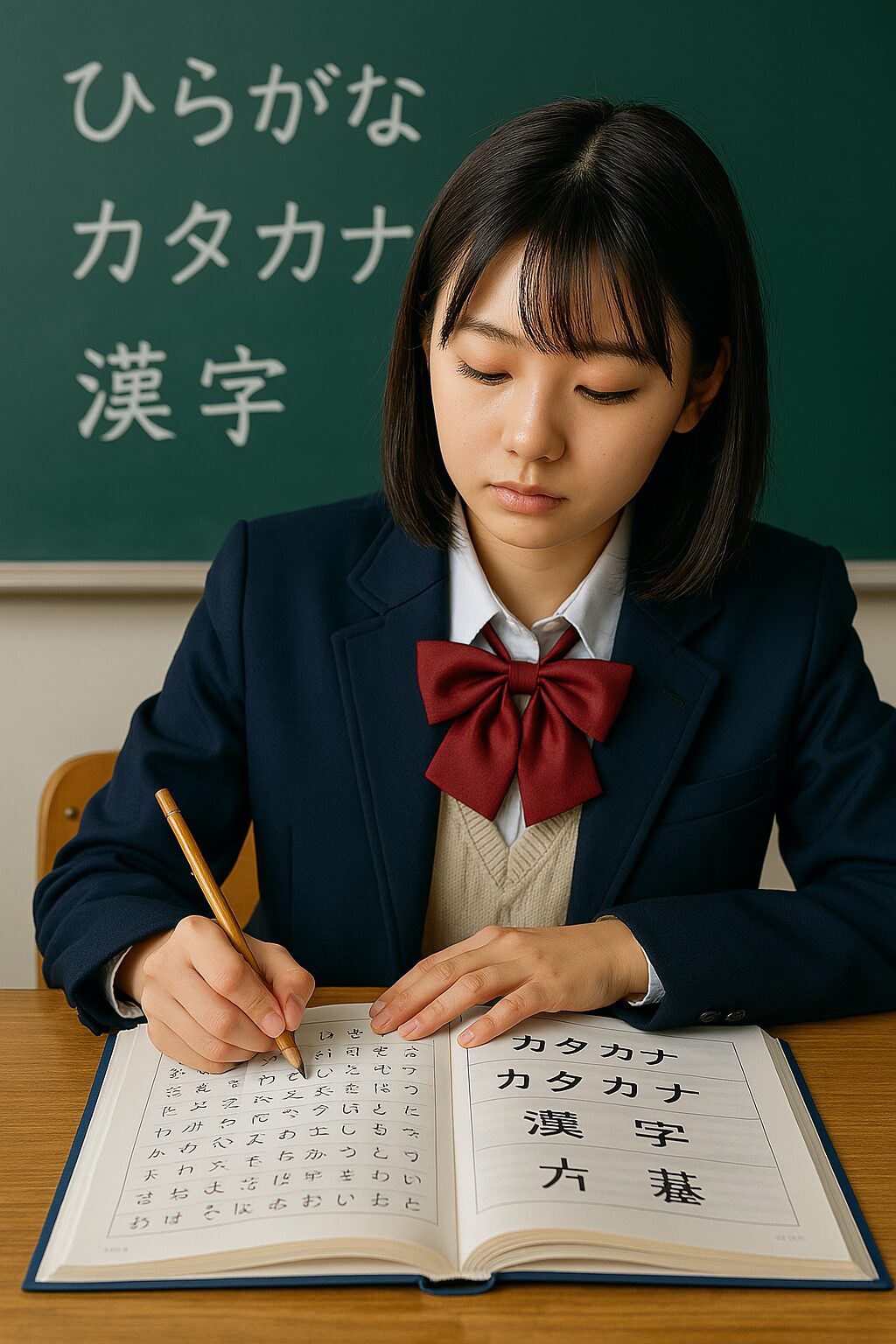- 🌟 Introduction: The Puzzle of the Japanese Language
- 🧠 Chapter 1: The Three Pillars of Japanese Writing—Hiragana, Katakana, and Kanji
- 📜 Chapter 2: Sacred Scripts from the Age of the Gods
- 🎭 Chapter 3: Grammar, Politeness, and the Art of Reading the Room
- 🏯 Chapter 4: Tradition Meets Technology in a Living Language
- 🧵 Final Thoughts: A Language With a Thousand Souls
🌟 Introduction: The Puzzle of the Japanese Language
Among the thousands of languages spoken around the world, Japanese stands out for its intricate structure and deep cultural resonance. With three writing systems, layered grammar rules, and nuanced expressions shaped by context and social relationships, it often appears enigmatic to non-native speakers.
Yet behind this complexity lies a story that spans thousands of years—from prehistoric rituals and secret scripts to digital slang and anime catchphrases. Japanese isn’t just a language. It’s the woven soul of a civilization.
Let’s unravel its mystery together.
🧠 Chapter 1: The Three Pillars of Japanese Writing—Hiragana, Katakana, and Kanji
Modern Japanese uses three distinct writing systems simultaneously, each with a unique role.
🈳 Hiragana – 46 Basic Characters
Gentle and curved, hiragana expresses native Japanese words and grammatical particles. Originating from handwritten cursive kanji, it was once reserved for aristocratic women. Today it’s essential for everything from poetry to everyday speech.
Example: わたしはにほんごがすきです。(“I like Japanese.”)
🈸 Katakana – 46 Basic Characters
Angular and sharp, katakana is used for foreign loanwords, technical terms, and emphasis. Derived from Buddhist texts, it once belonged to monks and scholars.
Example: コンビニでアイスクリームをかいました。(“I bought ice cream at the convenience store.”)
With expanded forms like ヴァ (va), ヴィ (vi), and ジェ (je), katakana now offers 100+ combinations for nuanced sound expression.
🉐 Kanji – Thousands of Characters
Adapted from Chinese characters, kanji conveys meaning through shape and symbolism. It’s the backbone of Japanese vocabulary and expression.
- Common use: ~3,000 characters
- Official sets: 2,136 “Jōyō” kanji + 863 “name” kanji
📚 Onyomi and Kunyomi: The Dual Readings of Kanji
| Reading Type | Origin & Usage | Examples |
|---|---|---|
| Onyomi (音読み) | Based on Chinese (Shina) pronunciation; used in compound words | 山 → san, 学 → gaku, 国 → koku |
| Kunyomi (訓読み) | Based on native Yamato words; aligns with traditional meanings | 山 → yama, 学 → manabu, 国 → kuni |
💡 For example, “山” in “富士山 (Fuji-san)” uses onyomi, while “やま” as a standalone word is kunyomi.
This dual system allows Japanese to express subtle shades of meaning and emotion.
📜 Chapter 2: Sacred Scripts from the Age of the Gods
Before kanji, some believe Japan had mysterious writing systems known as Jindai Moji and Ahiru Kusa Moji—literally “Divine Age Characters” and “Duck Grass Script.”
🌀 What Were These Scripts?
- Jindai Moji: Sacred symbols used by Shinto priests, believed to communicate divine will.
- Ahiru Kusa Moji: A cryptic, organic script resembling waves, spirals, and plants—used in esoteric rituals and ancient shrines.
🧭 Urban Legends and Secret Societies
- Shrines and caves across Japan—from Kumano to Kyushu—report carvings thought to be ancient glyphs.
- Rumors say a hidden society still guards these characters, decoding them through oral tradition.
- Some claim these symbols hold state secrets or cosmic knowledge, kept safe for millennia.
While academic circles often dismiss these scripts as myth, their existence in local folklore reinforces Japan’s mystique—where spirituality and language intertwine.
🎭 Chapter 3: Grammar, Politeness, and the Art of Reading the Room
Japanese grammar is more than rules—it’s a social code.
🧭 Sentence Structure
Unlike English’s SVO (Subject–Verb–Object), Japanese uses SOV:
I sushi eat → わたしはすしをたべます。
And often, subjects are dropped entirely—leaving meaning to be inferred from context, tone, or shared understanding.
🗣 Honorifics (Keigo)
Respect isn’t just felt—it’s spoken. Keigo is essential in Japanese, split into:
| Type | Purpose | Example |
|---|---|---|
| Sonkeigo | Elevates the listener | 社長がお話しになります (“The CEO speaks”) |
| Kenjōgo | Humbles the speaker | 私がご説明いたします (“I humbly explain”) |
| Teineigo | Adds politeness | 食べます (“I eat politely”) |
These honorifics aren’t optional—they’re deeply rooted in social harmony and group dynamics.
🎭 Spoken vs Written Japanese
| Phrase | Written | Casual | Slang |
|---|---|---|---|
| “I don’t know” | わかりません | わかんない | わかんね〜 |
| “That’s impossible” | それは困難です | それはむずかしい | それムリっしょ |
Japanese is shape-shifting: formal in the office, playful among friends, poetic in literature—and that’s just on a Tuesday.
🏯 Chapter 4: Tradition Meets Technology in a Living Language
Even amid digital transformation, Japanese retains its soul.
🎨 Emoji & Kaomoji
- 🤔 😊 😢 go beyond text—they express moods and unspoken nuance.
- ( ͡° ͜ʖ ͡°), (´・ω・`), \(o)/ are kaomoji, native to Japanese net culture.
They’re not decoration—they’re emotion in script.
📺 From Anime to Global Phenomenon
Anime and manga introduce expressive phrases that fuse all three writing systems:
- ツンデレ (tsundere): cold outside, warm inside
- 先輩 (senpai): respected older figure
- キュン (kyun): heart flutter
These words now circulate globally—proof of language as pop art.
📱 Abbreviated Expressions in Daily Life
- “りょ” (ryo) = “roger”
- “あざす” = “thanks”
- “おつ” = “good job”
Youth culture blends katakana, emoji, and condensed grammar to create agile, fast-paced expression. Japanese isn’t static—it evolves daily.
🧵 Final Thoughts: A Language With a Thousand Souls
Japanese is complex—but that’s its beauty.
From prehistoric stone tools and divine glyphs to anime jargon and spiritual respect, every corner of the language reflects something deeply human, deeply Japanese.
It isn’t hard because it’s flawed—it’s hard because it’s full of meaning.
For those who dare to learn it, Japanese offers more than communication—it offers insight, emotion, and connection. It’s not just a language—it’s a world.



コメント